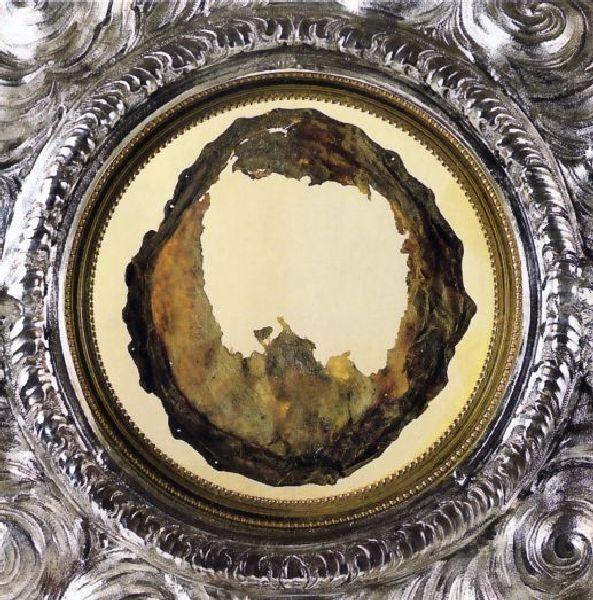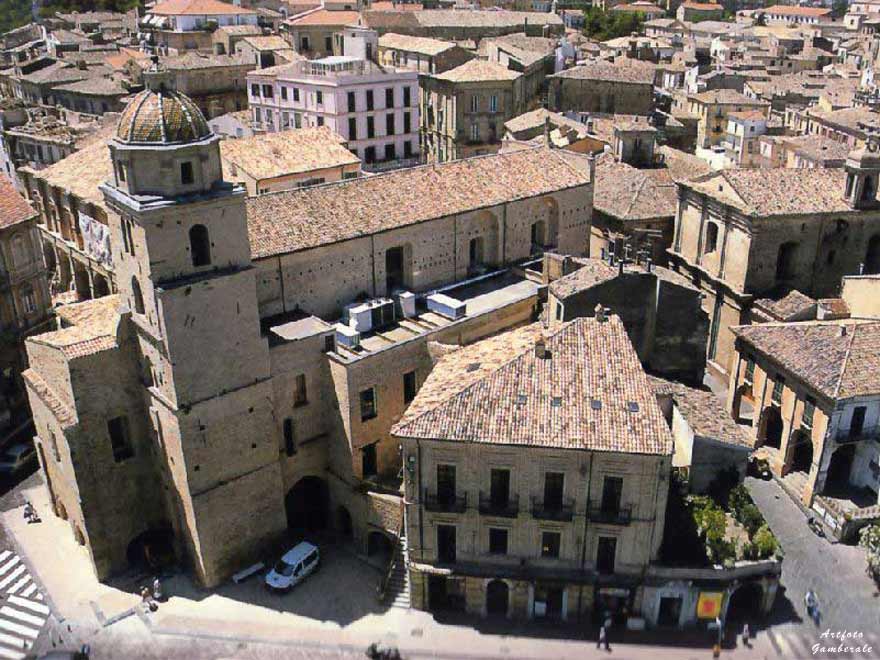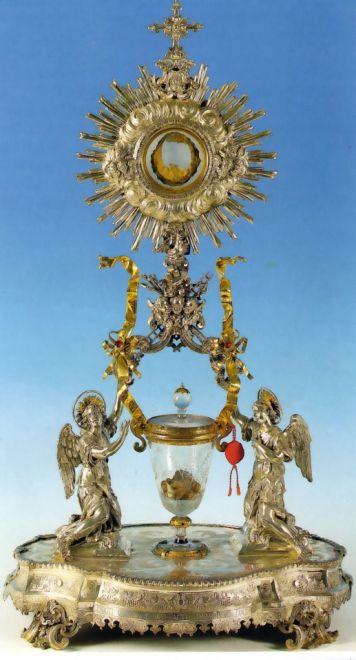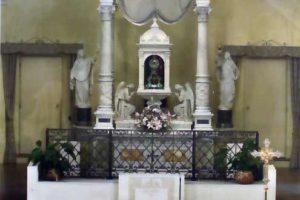Overview
Eucharistic Miracle of Lanciano
The Eucharistic Miracle of Lanciano happened in the eight century. This is inferred by circumstances and historical concomitance due to the persecution in the East from the Emperor Lion III, called The Isaurico, who started a strong persecution against Church and cult of sacred images.
Just to escape this persecution a lot f Greek monks fled to Italy, among these were Basilians monks, disciples of Saint Basil (329 – 379) Cesarea’s Bishop of Cappadocia (today Turkey). Some of those communities fled to Lanciano.
One day a monk during celebration of Mass had a doubt about the real presence of Jesus in the Host. Pronounced words of bread and wine consecration, suddenly, monk saw bread turn in to Flesh, and the wine in Blood.

Coming to Lanciano and having the best stay:
- Compare prices of hotels in Lanciano, for all pockets or view hotel deals at the bottom of the page that we have for you.
- Find cheap flights to Lanciano. Because you don’t want to overpay for your flight! 🙂
- Here is a selection of books about Miracle of the Eucharist
in Lanciano
- And something else for you, selection of:
Guides and tours:
View hotel deals in Lanciano:
Booking.com
See our Top 15 catholic shrines around the world.
See more Italian Catholic shrines and Basilicas
See more European Catholic Shrines and pilgrimages
Tradition unfortunately hasn’t given us registry data of the monk-priest whose hands are verified the extraordinary and unexpected change. We know that he was an oriental customary monk, Greek, belonging to the great spiritual family of Basilians.
A document of 1631, that reports Miracle with accuracy, paints the anonymous protagonist “not firm in the faith, expert of the world sciences but ignorant about God; he doubted day by day, if in the consecrated Host there was the true body of Christ and so in the wine the true blood”.
He was a man tormented by doubt, disorientated by the various tides of opinion, also in the field of faith, lacerated by the daily restlessness.
What was the reaction in front of unexpected change? According a document: “From so much and so stupendous miracle the monk was petrified and confused, he was transported, for a long, by a divine ecstasy, when finally the fear surrendered to the spiritual happy, that filled his soul, with an happy face and eyes full of tears, he turned toward faithful and said:
‘Or happy assistants to which God to confuse my incredulity has wanted to reveal in this holy Sacrament and to become visible to your eyes. Come here, brothers, and contemplate our God done next to us’”.
It is the common feeling that is accompanied to each experience of God and his mysterious to act with children’s men. The bread and the wine, invested, by the creative strength and sanctifier of he Word, are suddenly changed, totally and visibly in Flesh and Blood.
Date of the Miracle
there is no element that allow us to date the day, the month or the exact year in which Miracle happened. The late voice of historical testimony of oral tradition testimony together frame the Event inside the Eight century, without other precise statements.
The History of that Century help us. We know with certainty that in the East, under the Emperor Lion III, there was a strong iconoclast fight against the cult of sacred images, that was held legitimate and theologically unexceptionable by Roman Church. It was a painful story that increased the migratory flow of Greek monks to Italy, among these a little community fled to Lanciano.
According to this general picture of reference, we can hold in founded way that the Miracle was happened between 730 and 750 a.C.
Scientific Examination
To put aside from the positive results of the scientific search, who want know the history and the cult of Relics of the Eucharistic Miracle, has available information disseminated in the time; nevertheless it should not surprise anybody the shortage of the documentary material on an event that goes up again to the 700 a. C.
The first written document is of 1631 and narrate accurately what happened to the monk. Near sanctuary’s presbytery, on the right side of Valsecca Chapel, we can read the epigraph dated 1636, that narrates in synthesis the happened event.
We can add in this section also the different Miracle Recognition. These are historical and juridical verifications that affirm during centuries the Miracle authenticity by ecclesiastical Authority.
The first Recognition happened in 1574 from Archbishop Gaspare Rodriguez, who ascertained that the total weight of five clots of blood was the same weight of each of them.
This extraordinary event wasn’t subsequently verified. The actual total clots weight is grams 16,505, that of each of them is grams 8; grams 2,45; grams 2,85; grams 2,05 and grams 1,15. Is necessary to add milligram 5 of blood powder.
Different documents attest from the beginning of sixteenth century, the variation made to the“relics” and the tradition to bring them in procession during moments of serious and urgent necessity.
Further recognitions happened in 1637, 1770, 1866, 1970.
The town of Lanciano
The town of Lanciano boasts a millennial history. It was founded, earlier than Rome , by Solima, mythical companion of Enea, that called it Anxanon in honor of his brother Anxa
The ancient town stretched over three hills, in sight of the Adriatic sea and the Majella mountain, divided into four quarters, with nine gates, along the ancient walls, and nine fountains.
It became a Roman municipality in the second century b.C. and became famous over the centuries for its nundinae or trade fairs, thanks to which Lanciano has always been a vital center of trade.
In the following centuries it continued to be an important inhabitated area, as testament to this there is the Roman Diocletian bridge, the bold bridge, that supports the Cathedral with its powerful arches and that has joined for centuries the city center to the “fairs meadow”.
At the fall of the Roman Empire the Bizantian and Longobardic domination followed. In the 13th century Lancianowent throug a period of great vitality above all due to the policies of Federico II. It was elevated to “civitas” status in the 16th century.
For centuries the heart of the town has been the Piazza Plebiscito, in which the quarters of the old historic centre merge with the newer part of this lively town. Some emblem-buildings, as the Cathedral, the Church of Miracle, the City Hall, the Civic Tower, the Fenaroli Theatre look on the square.
The life of town has developed around the historic quarters that still today conserve their primitive conformation and that give testament to artistic and cultural vitality of this ancient frentanian centre through its numerous and precious monuments.
Between the last years of the 18th century and the beginnig of the 19th due to economic and demographic growth, the town developed strongly towards the period dominated by its trade fairs, giving life to the new part of town.
Let us remain close in the same prayer! May the Lord bless you abundantly!
Location of the relics
We are in the “beautiful country”, Italy, in Abruzzi, province of Chieti, Lanciano City. Near the central Plebiscito square, in the earth of the historical center it was open to the public a little church devoted to Saint Legonziano, submitted from the senate and people of Lanciano to a modest nucleus of Basilians monks landed in the chief town they brake as fugitives. The Eucharistic Miracle was verified in such temple and among the hands of one of these oriental monks.
Recent archeological searches affirm the Byzantines presence in this area in that time. Archeologists have recovered decorated ceramic finds to gangs typical of the Byzantine age. According to the Archeologist Andrea Staffa: “Exactly below the actual altar of the Sanctuary (of the San Francis Church) has been underlined a classroom in masonry, made of you tan quadrangular of stone, perhaps referable to the native plan of the place”.
Miracle Relics were guarded in the original church until 1258, then they passed to Benedicts (c. 1074) and, after a little pastors parenthesys (1229 – 1252) the passed definitely to the Franciscans.
The proximity of the flourishing monastery of Saint John in Venus (to the outskirts), monastery today submitted Passionists Fathers, in coincidence with the sunset of the Byzantine presence it favored the installation of the Benedictines in the church of Saint Legonziano, note among the years 1047 and 1076.
The Benedictine monastery started to live and to know its descending parable from 1225, after inside factors and behaviors anti-empire that decreed the expulsion from Lanciano during 1229.
And it was so that the Miracle’s Church was submitted to the local clergy to the archbishop up to the arrival of the Franciscans (April 3rd 1252). In 1258 Franciscans monks building again that church and they dedicated it to St Francis. These religious people, to them it turns, owed leave the place in 1809, when Napoleon I suppressed the religious orders. They got back their ancient convent only in June 1953.
Relics, locked in a reliquary of ivory, were first kept in the church of Saint Legonziano, then in the St Francis. At the time of the raids of the Turks in the Abruzzi, a minor monk named Giovanni Antonio of Mastro Renzo, wanted save them and, August 1st 1566, came bring them with him. But, after walking all night, found the next morning, still on the outskirts of Lanciano.
He realized then that he and his companions were to remain to preserve the relics. These, once past the danger, were placed on an altar worthy of them, on the right side of the nave of the church.
They were closed in a crystal vase, deposed in a wooden cupboard, closed with four keys. In 1920, Relics were placed behind the new great altar. Since 1923, the “flesh” is set in the spokes of monstrance, while clots of dried blood contained in a sort of crystal cup at the foot of the monstrance.
Saint Francesco’s Church
Started in 1252 and finished in 1258, in a Gothic style, this church was built in a “higher, adjacent area” to the one of St. Legonziano. The church is one of the first convents born in Abruzzo. The rectangular façade has got some square stones and it’s a wonderful example of the simple and solemn architecture, typical of the French Borgogna origins.
The upper part of the façade has been rebuilt, owing to a bad earthquake, in the first half of the eighteenth century. They used some stones coming from different countries and some materials taken from St. Angelo’s chapel (it was said of the Lombardi’s), which was inside the church.
The works, carried out in order to adapt the sanctuary to the aesthetic canons of the baroque style, were finished in the period between 1730 and 1745. They have given us the present appearance, as a big, tall single room. Nowadays, you can just see two altars of the six lateral ones, which there were in the past, near the presbytery.


Through the works of restoration carried out for the great Jubilee in 2000, the old appearance of the church, typical of the eighteenth century, was given back to it.
By keeping their sight on the left side, people who enter can meet the ca nvas devoted to the Virgin Mary of Graces, to St. Antonio from Padova and to the Virgin Mary of the Rosary.
On the vault of the aisle, you can admire some chromium-plated scenes, devoted to some biblical heroines, such as Judith, Esther and Rachel. They were painted by Donato Teodoro from Chieti. A venerable big wooden Crucifix of the eighteenth century is also well known.
The marble monument, which surrounds the very precious Relics, gripping them just like in a soft hug, was inaugurated on the 4th of October, in 1902. The masterpiece, carried out by Angelo Rocca from Carrara, made on commission of the engineer Filippo Sergiacomo, was reconstructed, lightened and lowered, in order to allow an easier entry to the Eucharist Miracle. The two statues, on the two sides, depicting the faith and the charity, have been made by Giovanni Scrivo from Naples (1904).
The two reliquaries are a goblet (it dates back to the seventeenth century) and an artistic silver monstrance, made by some artists from Naples (1713).
The monstrance, subsidized by Domenico Coli from Norcia, is a true jewel in its genre. Two angels are depicted on it: they are kneeling, as in a devout prayer. Each angel has got a flying about ribbon on his hand, where you can read the following Latin words:: “Tantum ergo sacramentum – veremur cernui”.
Let us remain close in the same prayer! May the Lord bless you abundantly!
Lanciano is 45 km from Pescara, 240 from Rome, 280 from Bari, 400 from Bologna and 600 from Milan. Thanks to its proximity to main roads connecting reach Lanciano to visit the Shrine of the Eucharistic Miracle is very simple..
By trian
Lanciano is served by a railway station near the city centre.
From East (Rome): the railway line Rome – Pescara links the capital and several cities of Abruzzo with Pescara. From there you can continue with one of the many regular trains that in about 30 minutes lead to the station of San Vito – Lanciano and then continue by bus or train of the Sangritana company.
From Nord (Ancona, Bologna, Milan) and from Sud (Termoli, Foggia, Brindisi, Lecce): the railway line Milan – Lecce connects the main cities of Adriatic backbone and the cities of North with train station of San Vito – Lanciano.
Schedules, information and reservations: Sangritana.it, Ferroviedellostato.it
By plane
The Abruzzo International Airport is just over 50 kilometers from the city. The airport is connected with the Rome airports of Fiumicino, Reggio Calabria, Olbia, Turin, Milan Malpensa and Linate Airport by the company ItaliAir; with Milan Linate airport by the airline AirOne, with several European cities by the airlines RyanAir and EuroAir. A weekly link connects the airport with New York (EuroFly) and Toronto (Skyservice). From airport continue to Lanciano reaching a taxi or bus station in central Pescara and from there taking a train or a bus. The time for all flights and information: Abruzzo International Airport
By car
From East (Rome): take the A24/A25 Rome – Pescara far as the junction with the A14 and continue to Bari. Along the A14 exit Lanciano.
From Nord and from Sud: along the A14 motorway Bologna – Taranto exit Lanciano and follow the signs to the city.
From East (Naples): si può percorrere l’autostrada A1 Milano – Napoli sino a Roma e successivamente percorrere interamente l’autostrada A24/A25 e, all’incrocio con l’A14, proseguire verso Bari. Lungo l’A14 uscire al casello di Lanciano. Altrimenti, sempre lungo l’A1, si può uscire al casello di Caianello e proseguire verso Venafro e poi Isernia. Da Isernia la SS 650 porta verso la A14 che si dovrà imboccare con direzione Bologna. L’uscita autostradale è Lanciano.
Information on routes and roads: Autostrade.it
By bus
From Rome: Lanciano is connected to Rome (Tiburtina station) from five daily runs of bus Di Fonzo.
From Bologna: four races of weekly bus of Sangritana link Lanciano (Piazzale Stazione) with Bologna (Station bus).
Several lines of the company Sangritana connect Lanciano with Pescara and the surrounding areas.
Schedules, information and reservations: Sangritana.it, DiFonzoViaggi.it
Let us remain close in the same prayer! May the Lord bless you abundantly!
Sundays/Holy Days:
- 7:30 am
- 9:00 am
- 10:30 am
- 6:30 pm
Weekdays:
- 8:00 am
- 9:00 am
- 6:30 pm
Let us remain close in the same prayer! May the Lord bless you abundantly!
Sundays/Holy Days:
- 6:45 am
- 12:15 am
- 3:00 pm
- 7:30 pm
Weekdays:
- 8:00 am
- 12:15 am
- 3:00 pm
- 7:30 pm
Let us remain close in the same prayer! May the Lord bless you abundantly!
Let us remain close in the same prayer! May the Lord bless you abundantly!
Let us remain close in the same prayer! May the Lord bless you abundantly!
Let us remain close in the same prayer! May the Lord bless you abundantly!
Date of the Miracle
We have no element that allow us to date the day, the month or the exact year in which Miracle happened. The late voice of historical testimony of oral tradition testimony together frame the Event inside the Eight century, without other precise statements.
The History of that Century help us. We know with certainty that in the East, under the Emperor Lion III, there was a strong iconoclast fight against the cult of sacred images, that was held legitimate and theologically unexceptionable by Roman Church. It was a painful story that increased the migratory flow of Greek monks to Italy, among these a little community fled to Lanciano.
According to this general picture of reference, we can hold in founded way that the Miracle was happened between 730 and 750 a.C.
Scientific Examination
To put aside from the positive results of the scientific search, who want know the history and the cult of Relics of the Eucharistic Miracle, has available information disseminated in the time; nevertheless it should not surprise anybody the shortage of the documentary material on an event that goes up again to the 700 a. C. Unfortunately and not only from files but also from other sources it results to ascertain the inconsiderate disappearance of documents and the irresponsible destruction of parchments happened in Lanciano and elsewhere. Overall, it can be attribute both to precarious political and social conditions verified on vast staircase, above all around thousand, both to other causes: to the shortage of the means of written (almost all submitted to oral tradition or to the indefatigable work of few amanuenses) we add fires and the devouring lootings, the frequent wars and the inevitable earthquakes, the human carelessness and the indifferent use of the parchments as cover of volumes as cups for the oil illumination or common paper to wind various commodity.
The first written document is of 1631 and narrate accurately what happened to the monk. Near sanctuary’s presbytery, on the right side of Valsecca Chapel, we can read the epigraph dated 1636, that narrates in synthesis the happened event.
We can add in this section also the different Miracle Recognition. These are historical and juridical verifications that affirm during centuries the Miracle authenticity by ecclesiastical Authority.
The first Recognition happened in 1574 from Archbishop Gaspare Rodriguez, who ascertained that the total weight of five clots of blood was the same weight of each of them. This extraordinary event wasn’t subsequently verified. The actual total clotsweight is grams16,505, that of each of them is grams 8; grams 2,45; grams 2,85; grams 2,05 and grams 1,15. Is necessary to add milligram 5 of blood powder. Different documents attest from the beginning of sixteenth century, the variation made to the“relics” and the tradition to bring them in procession during moments of serious and urgent necessity.
Further recognitions happened in 1637, 1770, 1866, 1970.
The town of Lanciano
The town of Lanciano boasts a millennial history. It was founded, earlier than Rome , by Solima, mythical companion of Enea, that called it Anxanon in honor of his brother Anxa
The ancient town stretched over three hills, in sight of the Adriatic sea and the Majella mountain, divided into four quarters, with nine gates, along the ancient walls, and nine fountains.
It became a Roman municipality in the second century b.C. and became famous over the centuries for its nundinae or trade fairs, thanks to which Lanciano has always been a vital center of trade.
In the following centuries it continued to be an important inhabitated area, as testament to this there is the Roman Diocletian bridge, the bold bridge, that supports the Cathedral with its powerful arches and that has joined for centuries the city center to the “fairs meadow”.
At the fall of the Roman Empire the Bizantian and Longobardic domination followed. In the 13th century Lancianowent throug a period of great vitality above all due to the policies of Federico II. It was elevated to “civitas” status in the 16th century.
For centuries the heart of the town has been the Piazza Plebiscito, in which the quarters of the old historic centre merge with the newer part of this lively town. Some emblem-buildings, as the Cathedral, the Church of Miracle, the City Hall, the Civic Tower, the Fenaroli Theatre look on the square. The life of town has developed around the historic quarters that still today conserve their primitive conformation and that give testament to artistic and cultural vitality of this ancient frentanian centre through its numerous and precious monuments.
Between the last years of the 18th century and the beginnig of the 19th due to economic and demographic growth, the town developed strongly towards the period dominated by its trade fairs, giving life to the new part of town.









































